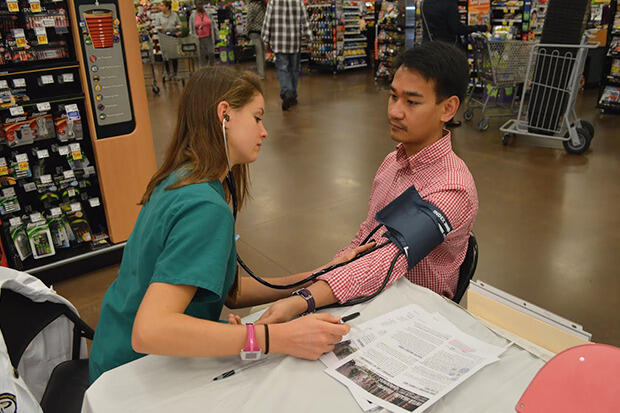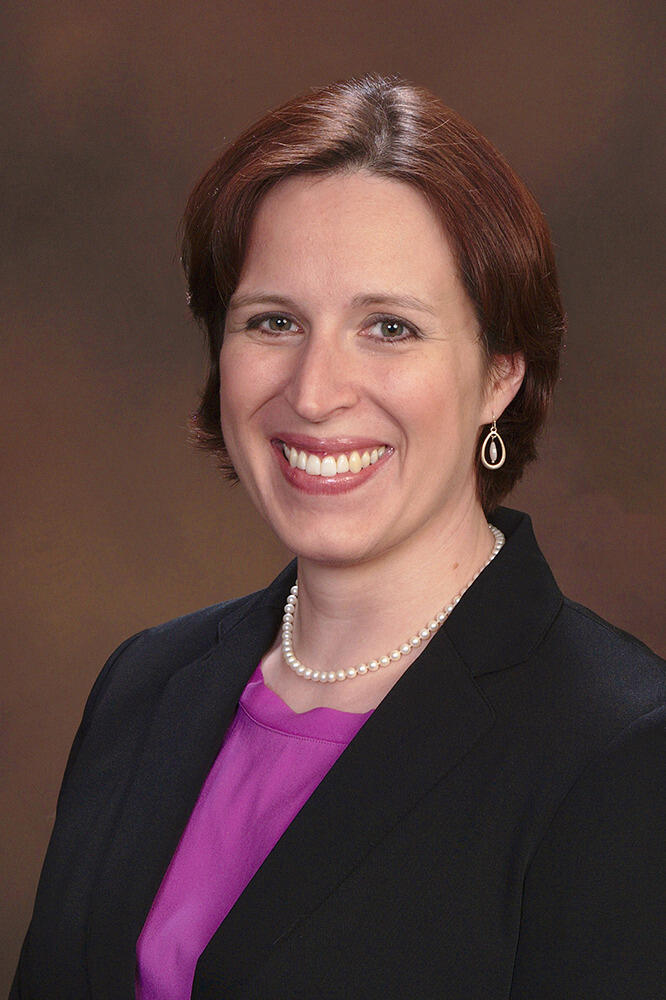
Dec. 16, 2014
Teaching teamwork: Health profession students collaborate on care
Share this story
When 79-year-old Floyd Roselli started falling a few times a week in the apartment that he shares with his black poodle named Lucky, an interdisciplinary team of health profession students from Virginia Commonwealth University knew they needed to intervene fast.
Roselli lives at Dominion Place, a low-income, high-rise apartment building near VCU’s Monroe Park campus. On Thursdays, VCU medicine, nursing and pharmacy students see residents during a free clinic on the first floor. Roselli had stopped by the clinic occasionally to have his blood pressure checked, but when he mentioned during a recent appointment that he’d been falling at night the students quickly switched gears from conducting a routine visit to working together as a team to improve his safety and reduce his risk of falling.
“The students are doing a lot of problem-solving,” said Alan Dow, M.D., assistant vice president of VCU Health Sciences’ Center for Interprofessional Education and Collaborative Care. In January 2013, Dow founded the center, which oversees various interprofessional academic courses, clinical programs and research projects. The Richmond Health and Wellness Program at Dominion Place is one of the projects that the center has helped develop.
Traditionally with health care education, individual disciplines are taught separately and then the graduates of each school come together as a team to care for patients. Interprofessional education provides students from a variety of health care professions the opportunity to work together while still in school, so that they can prepare for the team-based approach.
“If we start teaching students interdisciplinary health care now then over time a cultural change will take place and care will begin to be delivered differently for the next generation’s health care workforce,” said Pam Parsons, Ph.D., geriatric nurse practitioner and associate professor in the VCU School of Nursing. Parsons is the project director for the Richmond Health and Wellness Program, which started in July 2013 and is funded by a three-year, $1.5 million grant from the U.S. Department of Health and Human Services’ Human Resources and Services Administration.
Like other IPE partners, the Richmond Health and Wellness Program is designed to get multiple health care profession students working as a team before their first day on the job.
Detective diagnosis

A wreath hangs on the door of Roselli’s 12th-floor apartment next to a sticker that says “I love my dog.” Inside, artwork and pictures of friends adorn the walls of the 450-square-foot space. “The Price is Right” plays on a television in the living room corner, where a wall is chipped from when Roselli attempted to move from his wheelchair to the bedroom.
“Mr. Roselli is an interesting resident here because he is unable to transfer from place to place,” said fourth-year pharmacy student Daniel Ngembus. After Roselli reported the falls, the 27-year-old visited him at his home with nursing students and Richmond Health and Wellness program faculty to get more clues about the factors that might have contributed to the problem. While he was there, he took a medical history and asked about Roselli’s prescriptions. “The way his apartment is set up, it has some sharp turns,” Ngembus said. “You might see some slight wall damages that are associated with him moving around.”
After the visit, Parsons and the students in the program scheduled a primary care appointment for Roselli at a nearby family practice and helped to arrange his transportation. They also connected him with Meals on Wheels.
“They help me a lot,” Roselli said. The Richmond native who used to transport radioactive material along the East Coast has lived at Dominion Place for 22 years. With a medical record that includes a history of prostate cancer, diabetes, high blood pressure and arthritis, which confines him to a wheelchair for most of the day, Roselli is the type of complex patient that students are being trained to treat through an interprofessional approach.
“The students are learning how to integrate the medical parts of care with the social aspects of care delivery, all in an effort to improve the health of the [Dominion Place] community,” Dow said.
Foundations of care

In 2011, Dow received a two-year, $200,000 award from the Josiah H. Macy Jr. Foundation to create an interprofessional curriculum at VCU. The grant was intended to fund Dow’s work melding programs across all five health sciences schools, which include nursing, medicine, pharmacy, dentistry and allied health professions.
“We’re trying to develop a sequence of learning activities that goes throughout the training of our students so that they’re developing interprofessional competencies over time,” Dow said.
The idea is that teaching interprofessional collaboration during school will improve health and contain health care costs in the professional arena down the road because better teamwork in education leads to more comprehensive care, fewer hospital readmissions and fewer errors and unnecessary procedures in the future.
“The evidence is starting to show that health care teams provide better outcomes,” said Barbara Brandt, Ph.D., director of the National Center for Interprofessional Practice and Education at the University of Minnesota Academic Health Center.
While it is difficult to quantitatively measure the success of interprofessional education since students disperse into a wide array of professional tracks after graduating, Dow said that the feedback he receives from students is positive.
“As faculty, we’ve been able to observe better collaborative skills as students go through the programs,” he said.
Burgeoning curriculum

Starting in the fall 2015 academic year, a new one-credit course designed for first-year health science students will be integrated into various degree programs throughout campus. The 600-person course, which Dow developed with faculty members from all of the health sciences schools, divides students into teams of health disciplines to learn how to work together to take care of patients. The course will start with a short lecture and then the students will break into teams of various health disciplines to work on projects related to the health care system.
“A lot of it is just them getting comfortable collaborating in the classroom setting and beginning to understand each other’s professional perspectives so that when they get into the clinical environment they’ve got a good foundation on which to continue to work as team members,” Dow said.
One of those environments at VCU is the curriculum of simulation-based experiences that Dow and two nursing faculty members created in 2011. During the interprofessional critical care simulations, fourth-year medical and nursing students attend three two-hour sessions in which a high-fidelity simulator reproduces a patient experiencing a crisis such as cardiac arrest, a seizure or a stroke. Through treating the simulator, students practice using team-based resources to care for critically ill patients. About 320 fourth-year students participate every year in the course, which has been featured in the U.S. News & World Report’s best graduate schools issue.
“The idea is to get students ready for their first day on the job so that if something bad starts happening to one of their patients, they know how to intervene,” Dow said. “Part of that includes knowing the critical care skills that they need to help the patient, but part of it also is being able to collaborate across professions with nurses and doctors together.”
Community resource

One Saturday a month, students from the VCU Health Sciences schools, along with students from social work, biomedical engineering and the VCU Dietetic Internship Program, gather at the Kroger on North Lombardy Street to talk with customers about healthy lifestyles and provide health screenings.
“Ironically, we’re usually set up in front of the candy aisle,” said Sarah Barden. The fourth-year pharmacy student is the president of the VCU Inter Health Professionals Alliance, an interdisciplinary outreach group that provides health education to the community.
Dow is the faculty adviser to the organization, which, with 420 members, is the largest interprofessional student organization at VCU.
In addition to the outreach events at Kroger where students distribute a newsletter about a monthly health topic and offer free blood pressure screenings, IHPA hosts educational sessions for members in which students teach each other about health topics from the perspective of their individual disciplines.

“The more I can understand how the pieces fit together, the better I can do my part,” Barden said. “The point is to give students an opportunity to learn from and work with other health professional students to build those relationships early.”
In 2013, pharmacy student DaleMarie Vaughn, who was a member of IHPA, started a schoolwide interprofessional case competition to determine which students would advance to an annual national competition. During the Clarion National Case Competition, interprofessional student teams are given a patient case and are charged with finding the cause of the health problem and coming up with a solution. The team presents their analysis to a panel of interprofessional judges that evaluates their presentation in the context of real world standards of practice.
“The teams have to take a big picture approach to come up with a solution to the problem,” Barden said.
This year, the teams will present their solutions at the Emswiller Symposium, a regional interprofessional education conference hosted by VCU.
Case study
A couple weeks after Dominion Place resident Floyd Roselli reported falls to his VCU health care team, the students helped him organize his medications and procured a new electric wheelchair that was paid for through the Medicaid they helped to renew for him. Meals on Wheels brings Roselli two meals a day and the volunteers have even started bringing a meal for his dog, Lucky.
“They kept on to [Medicaid] until I got a new wheelchair,” Roselli said as he sat in his new electric wheelchair at the entrance of Dominion Place after returning from a trip around the Fan with Lucky. His old wheelchair would sometimes stop unexpectedly and Roselli would have to ask someone to help push him back to his apartment.
“He is really happy,” Parsons said. The Richmond Health and Wellness program director plans to use Roselli’s story as a case study on complex patients in her classes and to create protocols for what to do if a case like his ever arises again within the program. “That will help him, his providers in the community, and the Dominion Place management team,” she said. “It will be a wonderful learning opportunity for the students.”
As the Center for Interprofessional Education and Collaborative Care continues to grow, students will have more opportunities to learn from each other during new classes and student-led programs with the ultimate goal of providing better quality care to the patients they serve.
“We are trying to prepare our students for new models of care so that as things continue to change, our students are ready to lead and collaborate in teams to improve the health of their communities,” Dow said.
We are trying to prepare our students for new models of care so that as things continue to change, our students are ready to lead and collaborate in teams to improve the health of their communities.
Subscribe for free to the weekly VCU News email newsletter at http://newsletter.news.vcu.edu/ and receive a selection of stories, videos, photos, news clips and event listings in your inbox every Thursday. VCU students, faculty and staff automatically receive the newsletter.
Subscribe to VCU News
Subscribe to VCU News at newsletter.vcu.edu and receive a selection of stories, videos, photos, news clips and event listings in your inbox.






